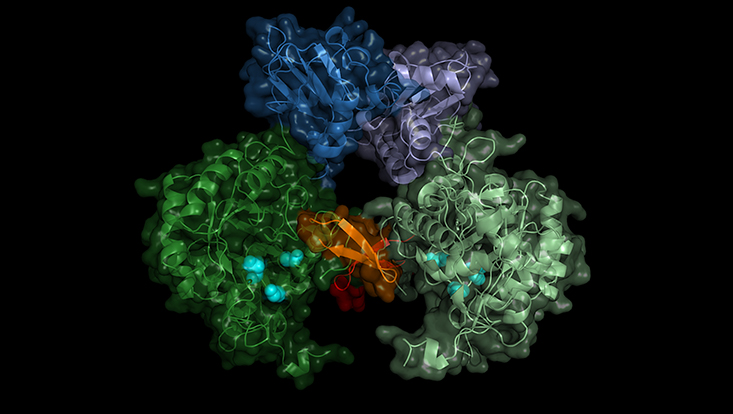Research Results

Photo: Universität Lübeck/DESY, Lars Redecke
Excellent basic research is the basis for innovative products. In this context, technological progress is always closely linked to the possibility of observing matter and its motion on ever shorter length and time scales. Selected examples show how CUI researchers bring the results of basic research through to application.
Applied Nanotechnology
Prof. Horst Weller
- Founding director of the Fraunhofer Center for Applied Nanotechnology CAN, started in 2005 by founding CAN GmbH as a public-private partnership between FHH, UHH and industrial partners.
- Prof. Weller was a spokesperson of CUI until his retirement at the end of 2022 and responsible for transfer. He was a member of Universität Hamburg's Transfer Council.
- Projects on the medical application of fluorescent and magnetic nanoparticles in diagnostics and therapy (e.g. together with the UKE).
Corona virus research
Prof. Henry Chapman (further contributors Prof. Christian Betzel, Prof. Arwen Pearson)
-
Research and development: X-ray crystallographic screening of SARS-CoV-2 virus proteins in collaboration with libraries re-evaluating drugs.
-
Goal: New capacity/facilities then available for pharmaceutical research and drug development and development of software for freely available high throughput screening.
-
Implementation: In partnership with Fraunhofer Institute and direct links to industry.
-
Compact X-ray light sources (developed by Prof. Franz Kaertner) enable many of the X-ray imaging and analysis methods to be brought to a wider market.
Corona Structural Taskforce
Dr. Andrea Thorn
- Information about Corona for the public at insidecorona.de.
- Providing a realistic 3D model of the virus, an antibody and a rhinovirus for comparison to schools and the public.
- Public education about the mechanisms of the virus: lectures, interviews, general scientific articles in magazines.
- Use of in-house developed software Auspex for analyzing the performance of X-ray diffraction devices and modern detectors at companies such as Bruker AXS, Dectric, Rigaku, etc.
Biomedical applications (tumor research / coronavirus)
Dr. Irene Fernandez Cuesta
- Research: Detection and analysis of individual biomolecules using integrated nanofluidic devices and optical methods.
- Goal: Encoding DNA for biomedical applications (e.g., to study viruses or tumor cells) with barcodes, and developing new methods to use protein biomarkers as well.
- Further application: Detection and quantification of single virions with a mobile system (e.g. for direct use in Corona pandemic).
HALOS Initiative
Prof. Arwen Pearson
- Explicit cooperation aktivities (halos) with industry in southern Sweden, Denmark and northern Germany, mainly to link science and industry in the Skåne region, Kron Region Denmark and the city of Hamburg.
- Seminar series, outreach material, support to industry for access to large-scale research facilities, support in experimental design, data analysis.
- Close connection to Medicon Valley Alliance, co-organization of TechConnect Europe meeting.
Cycle GmbH
Prof. Franz Kärtner
Spin-Off Firma Cycle GmbH (www.cyclelasers.com), founded in 2015, 15 employees.
- Products: Femtosecond synchronization systems as well as ultrashort pulse lasers. The femtosecond synchronization technology was developed specifically for time-resolved serial X-ray crystallography, as used by Prof. Chapman and others. The ultrashort pulse lasers are needed for, among other things, Multimodal Multiphoton Microscopy (M3). Initial versions of the M3 laser were originally developed for the detection of nanocrystals for X-ray crystallography in collaboration with Prof. Betzel and Prof. Chapman.
- Applications: E.g., femtosecond synchronization systems are used to synchronize large-scale research equipment such as X-ray and high-power lasers, as well as to transmit very low-noise radio-frequency signals for the European Space Agency's (ESA) next-generation Deep Space Tracking Stations.
- The M3 laser: essential product for evolving 3-photon microscopy in neuroscience and possibly in non-invasive skin cancer screening.
Laser technology
Prof. Roman Schnabel
- Laser light with correlated quantum fuzziness is not yet commercially available, but represents an essential technology of the second quantum revolution.
- Collaboration between two clusters of excellence: in Quantum Universe, appropriate light sources are being developed to increase the sensitivity of gravitational wave observatories; in the CUI cluster, potential resources for quantum computers are being explored.
- Shorter-term applications in industry have already been explored.
- 2022: Spin-off of a company from Universität of Hamburg (ILP, AG Prof. Schnabel), which will then offer such lasers for the first time worldwide.
Electron and ion optics
Prof. Markus Drescher
- Development of a new instrument for the analysis of electrons and ions from cold quantum gases.
- The technology for ion and electron optics was submitted as an EU patent via the TransferAgency of Universität Hamburg: P. Wessels-Staarmann, J. Heyer, and M. Drescher, EU Patent Application No. 22 183 392.4 (2022).
- Development of a high-performance, extreme ultraviolet radiation source in MEGA-EUV, a cooperative project between Universität Hamburg, DESY, Class 5 Photonics and Amphos GmbH as well as other partners in the semiconductor industry.
WiredSense GmbH
Dr. Philipp Wessels-Staarmann
Advising the start-up WiredSense GmbH (https://www.wiredsense.com/), a spin-off from the Max Planck Institute for the Structure and Dynamics of Matter, located in the Start-up Labs Bahrenfeld (https://slb.hamburg/) Goal: Distribution of fastest THz detectors available.
- Dr. Philipp Wessels-Staarmann is involved in the development of the infrared spectrometer Sweeb (https://www.wiredsense.com/page/sweeb) based on this detector technology. Such a spectrometer can analyze the exact composition of materials based on the spectroscopic IR fingerprint.
- Areas of Focus: Optics development, intellectual property and patents. Filing of two patents in the field of optics and amplifier electronics.
- The goal is to make the versatile technology of infrared spectroscopy available for a broad spectrum of users, such as pharmacies, by means of innovative developments.
- WiredSense has received InnoRampUp Funding from the Hamburg Investment and Development Bank (IFB Hamburg) and recently also won the Gründergeist 2022 competition.
Lu:bici
Dr. Arthur Feld
The former postdoc in Prof Horst Weller's group and current guest researcher in Prof Nadja Bigall's group is being supported with an EXIST start-up grant for his NanoLube project (https://www.exist.de/EXIST/Navigation/EN/Start-upFunding/EXIST-Business-Start-up-Grant/exist-business-start-up-grant.html).
- Feld has developed an innovative wax product for bicycle chains, which he will market together with co-founder Britta Kloust. The one-step solution for changing oil to wax will be available from spring 2025 under the name lu:bici.
